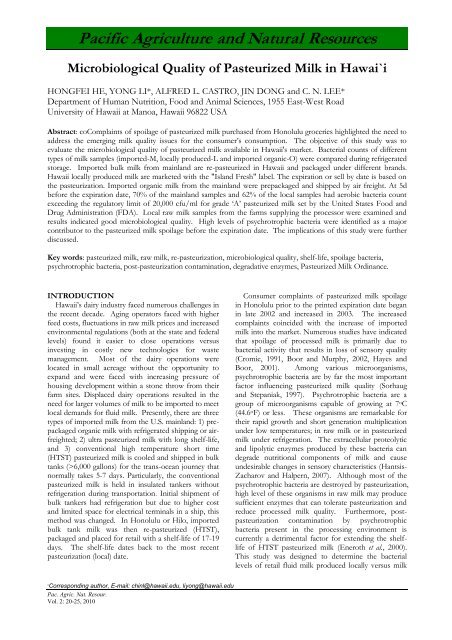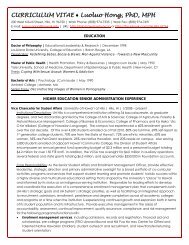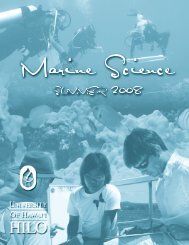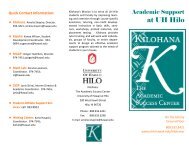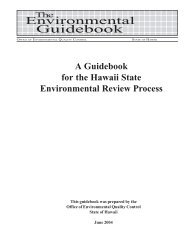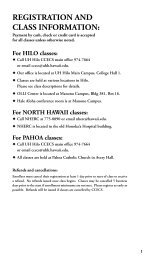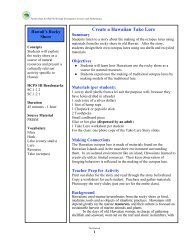Microbiological Quality of Pasteurized Milk in Hawai`i - University of ...
Microbiological Quality of Pasteurized Milk in Hawai`i - University of ...
Microbiological Quality of Pasteurized Milk in Hawai`i - University of ...
You also want an ePaper? Increase the reach of your titles
YUMPU automatically turns print PDFs into web optimized ePapers that Google loves.
Pacific Agriculture and Natural Resources<br />
<strong>Microbiological</strong> <strong>Quality</strong> <strong>of</strong> <strong>Pasteurized</strong> <strong>Milk</strong> <strong>in</strong> <strong>Hawai`i</strong><br />
HONGFEI HE, YONG LI*, ALFRED L. CASTRO, JIN DONG and C. N. LEE*<br />
Department <strong>of</strong> Human Nutrition, Food and Animal Sciences, 1955 East-West Road<br />
<strong>University</strong> <strong>of</strong> Hawaii at Manoa, Hawaii 96822 USA<br />
Abstract: coCompla<strong>in</strong>ts <strong>of</strong> spoilage <strong>of</strong> pasteurized milk purchased from Honolulu groceries highlighted the need to<br />
address the emerg<strong>in</strong>g milk quality issues for the consumer’s consumption. The objective <strong>of</strong> this study was to<br />
evaluate the microbiological quality <strong>of</strong> pasteurized milk available <strong>in</strong> Hawaii's market. Bacterial counts <strong>of</strong> different<br />
types <strong>of</strong> milk samples (imported-M, locally produced-L and imported organic-O) were compared dur<strong>in</strong>g refrigerated<br />
storage. Imported bulk milk from ma<strong>in</strong>land are re-pasteurized <strong>in</strong> Hawaii and packaged under different brands.<br />
Hawaii locally produced milk are marketed with the "Island Fresh" label. The expiration or sell by date is based on<br />
the pasteurization. Imported organic milk from the ma<strong>in</strong>land were prepackaged and shipped by air freight. At 5d<br />
before the expiration date, 70% <strong>of</strong> the ma<strong>in</strong>land samples and 62% <strong>of</strong> the local samples had aerobic bacteria count<br />
exceed<strong>in</strong>g the regulatory limit <strong>of</strong> 20,000 cfu/ml for grade ‘A’ pasteurized milk set by the United States Food and<br />
Drug Adm<strong>in</strong>istration (FDA). Local raw milk samples from the farms supply<strong>in</strong>g the processor were exam<strong>in</strong>ed and<br />
results <strong>in</strong>dicated good microbiological quality. High levels <strong>of</strong> psychrotrophic bacteria were identified as a major<br />
contributor to the pasteurized milk spoilage before the expiration date. The implications <strong>of</strong> this study were further<br />
discussed.<br />
Key words: pasteurized milk, raw milk, re-pasteurization, microbiological quality, shelf-life, spoilage bacteria,<br />
psychrotrophic bacteria, post-pasteurization contam<strong>in</strong>ation, degradative enzymes, <strong>Pasteurized</strong> <strong>Milk</strong> Ord<strong>in</strong>ance.<br />
INTRODUCTION<br />
Hawaii’s dairy <strong>in</strong>dustry faced numerous challenges <strong>in</strong><br />
the recent decade. Ag<strong>in</strong>g operators faced with higher<br />
feed costs, fluctuations <strong>in</strong> raw milk prices and <strong>in</strong>creased<br />
environmental regulations (both at the state and federal<br />
levels) found it easier to close operations versus<br />
<strong>in</strong>vest<strong>in</strong>g <strong>in</strong> costly new technologies for waste<br />
management. Most <strong>of</strong> the dairy operations were<br />
located <strong>in</strong> small acreage without the opportunity to<br />
expand and were faced with <strong>in</strong>creas<strong>in</strong>g pressure <strong>of</strong><br />
hous<strong>in</strong>g development with<strong>in</strong> a stone throw from their<br />
farm sites. Displaced dairy operations resulted <strong>in</strong> the<br />
need for larger volumes <strong>of</strong> milk to be imported to meet<br />
local demands for fluid milk. Presently, there are three<br />
types <strong>of</strong> imported milk from the U.S. ma<strong>in</strong>land: 1) prepackaged<br />
organic milk with refrigerated shipp<strong>in</strong>g or airfreighted;<br />
2) ultra pasteurized milk with long shelf-life,<br />
and 3) conventional high temperature short time<br />
(HTST) pasteurized milk is cooled and shipped <strong>in</strong> bulk<br />
tanks (>6,000 gallons) for the trans-ocean journey that<br />
normally takes 5-7 days. Particularly, the conventional<br />
pasteurized milk is held <strong>in</strong> <strong>in</strong>sulated tankers without<br />
refrigeration dur<strong>in</strong>g transportation. Initial shipment <strong>of</strong><br />
bulk tankers had refrigeration but due to higher cost<br />
and limited space for electrical term<strong>in</strong>als <strong>in</strong> a ship, this<br />
method was changed. In Honolulu or Hilo, imported<br />
bulk tank milk was then re-pasteurized (HTST),<br />
packaged and placed for retail with a shelf-life <strong>of</strong> 17-19<br />
days. The shelf-life dates back to the most recent<br />
pasteurization (local) date.<br />
Consumer compla<strong>in</strong>ts <strong>of</strong> pasteurized milk spoilage<br />
<strong>in</strong> Honolulu prior to the pr<strong>in</strong>ted expiration date began<br />
<strong>in</strong> late 2002 and <strong>in</strong>creased <strong>in</strong> 2003. The <strong>in</strong>creased<br />
compla<strong>in</strong>ts co<strong>in</strong>cided with the <strong>in</strong>crease <strong>of</strong> imported<br />
milk <strong>in</strong>to the market. Numerous studies have <strong>in</strong>dicated<br />
that spoilage <strong>of</strong> processed milk is primarily due to<br />
bacterial activity that results <strong>in</strong> loss <strong>of</strong> sensory quality<br />
(Cromie, 1991, Boor and Murphy, 2002, Hayes and<br />
Boor, 2001). Among various microorganisms,<br />
psychrotrophic bacteria are by far the most important<br />
factor <strong>in</strong>fluenc<strong>in</strong>g pasteurized milk quality (Sorhaug<br />
and Stepaniak, 1997). Psychrotrophic bacteria are a<br />
group <strong>of</strong> microorganisms capable <strong>of</strong> grow<strong>in</strong>g at 7 o C<br />
(44.6 o F) or less. These organisms are remarkable for<br />
their rapid growth and short generation multiplication<br />
under low temperatures; <strong>in</strong> raw milk or <strong>in</strong> pasteurized<br />
milk under refrigeration. The extracellular proteolytic<br />
and lipolytic enzymes produced by these bacteria can<br />
degrade nutritional components <strong>of</strong> milk and cause<br />
undesirable changes <strong>in</strong> sensory characteristics (Hantsis-<br />
Zacharov and Halpern, 2007). Although most <strong>of</strong> the<br />
psychrotrophic bacteria are destroyed by pasteurization,<br />
high level <strong>of</strong> these organisms <strong>in</strong> raw milk may produce<br />
sufficient enzymes that can tolerate pasteurization and<br />
reduce processed milk quality. Furthermore, postpasteurization<br />
contam<strong>in</strong>ation by psychrotrophic<br />
bacteria present <strong>in</strong> the process<strong>in</strong>g environment is<br />
currently a detrimental factor for extend<strong>in</strong>g the shelflife<br />
<strong>of</strong> HTST pasteurized milk (Eneroth et al., 2000).<br />
This study was designed to determ<strong>in</strong>e the bacterial<br />
levels <strong>of</strong> retail fluid milk produced locally versus milk<br />
∗Correspond<strong>in</strong>g author, E-mail: ch<strong>in</strong>l@hawaii.edu, liyong@hawaii.edu<br />
Pac. Agric. Nat. Resour.<br />
Vol. 2: 20-25, 2010
Hongfei he, Yong Li, Alfred L., et al. 21<br />
imported and re-pasteurized. The general goal was to<br />
validate the legitimacy <strong>of</strong> the consumer compla<strong>in</strong>ts.<br />
The hypothesis was that early spoilage <strong>of</strong> imported<br />
milk was due to higher psychrotrophic bacteria count<br />
even under proper handl<strong>in</strong>g.<br />
MATERIALS AND METHODS<br />
Sample collection<br />
The first study was conducted to evaluate the<br />
microbiological quality <strong>of</strong> pasteurized milk available <strong>in</strong><br />
Honolulu. Three types <strong>of</strong> milk with 2% fat were<br />
selected: imported pasteurized milk from ma<strong>in</strong>land and<br />
re-pasteurized locally (M), locally produced and<br />
pasteurized milk (L), and imported pre-packaged<br />
organic milk (O). The study was conducted over a<br />
period <strong>of</strong> several months (August 2006-April 2007). A<br />
total <strong>of</strong> 45 commercial pasteurized milk samples were<br />
randomly purchased from local grocery stores <strong>in</strong><br />
Honolulu. The sampl<strong>in</strong>g plan consisted <strong>of</strong> collect<strong>in</strong>g<br />
15 samples <strong>of</strong> each type (M, L, and O). Over 9 brands<br />
<strong>of</strong> milk from 10 stores were sampled. Local milk<br />
samples were identified by the smil<strong>in</strong>g daisy logo -<br />
"Island Fresh". The time taken to transport the milk<br />
from the stores to the laboratory was less than 10 m<strong>in</strong>.<br />
Samples were purchased <strong>in</strong> the even<strong>in</strong>g when the day<br />
was cooler and the traffic was lighter.<br />
In the second study, the microbiological quality <strong>of</strong><br />
local raw milk was evaluated. A total <strong>of</strong> six raw milk<br />
samples were randomly collected from local dairy<br />
farms and transported to the laboratory <strong>in</strong> ice <strong>in</strong> a<br />
cooler. In the third study, the bacterial level <strong>of</strong><br />
pasteurized milk sold <strong>in</strong> the Big Island (Hawaii) was<br />
exam<strong>in</strong>ed; 5 M samples and 9 L samples from the<br />
grocery stores <strong>in</strong> the Big Island were purchased and<br />
transported by air to our laboratory <strong>in</strong> coolers<br />
conta<strong>in</strong><strong>in</strong>g coolant packs. A fourth study was<br />
conducted to evaluate the effect <strong>of</strong> storage temperature<br />
on microbial population <strong>in</strong> milk. This "stress test" was<br />
conducted 15 months later, under a separate grant.<br />
All milk samples were stored at 4ºC <strong>in</strong> the laboratory<br />
and handled accord<strong>in</strong>g to Standard Methods for the<br />
Exam<strong>in</strong>ation <strong>of</strong> Dairy Products (Wehr and Frank,<br />
2004).<br />
<strong>Microbiological</strong> evaluation<br />
At five days before expiration (-5), day <strong>of</strong> expiration<br />
(0), and three days after expiration (+3), the samples<br />
were analyzed for aerobic plate count (APC) and rapid<br />
psychrotrophic count (RPC). Raw milk samples were<br />
tested for APC and RPC with<strong>in</strong> 2 h after on farm<br />
collection. The milk samples were serially diluted <strong>in</strong><br />
0.1% peptone water and spread on plate count agar<br />
(BD Diagnostic Systems, Sparks, Md.). The plates<br />
were <strong>in</strong>cubated at 35ºC for 48 h to determ<strong>in</strong>e APC or<br />
at 21ºC for 48 h to determ<strong>in</strong>e RPC (Oliveria and<br />
Parmelee, 1976). All HTST processed milk products<br />
with different brands (M and L) <strong>in</strong> Hawaii were<br />
processed by the only process<strong>in</strong>g plant <strong>in</strong> Honolulu<br />
and on the Big Island, respectively. The O type milk<br />
tested was normally imported via air shipment from the<br />
west coast.<br />
Growth <strong>of</strong> bacteria under different<br />
refrigeration temperature<br />
In the fourth study aimed at determ<strong>in</strong><strong>in</strong>g the effects<br />
<strong>of</strong> different refrigeration temperatures on bacterial<br />
growth <strong>in</strong> pasteurized milk (12 samples) that were<br />
randomly purchased <strong>in</strong> Honolulu were exam<strong>in</strong>ed.<br />
Upon receipt <strong>in</strong> the laboratory, each milk sample was<br />
aseptically aliquoted <strong>in</strong>to two sterile 50 ml bottles, one<br />
stored at 4 ºC and the other stored at 7 ºC for shelf-life<br />
study. At 10, 7 and 5 days before expiration, these<br />
samples were analyzed for APC and RPC. This study<br />
was part <strong>of</strong> a subsequent grant to perform<br />
f<strong>in</strong>gerpr<strong>in</strong>t<strong>in</strong>g <strong>of</strong> the spoilage-caus<strong>in</strong>g bacteria <strong>in</strong> milk.<br />
It was conducted 15 months later. The data fits this<br />
presentation as it provided a more complete picture <strong>of</strong><br />
what is happen<strong>in</strong>g <strong>in</strong> milk microbial population<br />
Statistical analysis<br />
The APC and RPC data were transformed us<strong>in</strong>g<br />
log 10CFU/ml. Differences between mean microbial<br />
counts <strong>of</strong> M, L and O samples were analyzed at each<br />
sampl<strong>in</strong>g time us<strong>in</strong>g multi-variate analysis <strong>of</strong> variance.<br />
The APC and RPC data from the study <strong>of</strong> storage<br />
temperature effects on microbial growth were analyzed<br />
us<strong>in</strong>g paired t-test. All statistical analyses were<br />
performed with SAS ® 9.1 (SAS Institute Inc.).<br />
Results<br />
Figure 1 showed the bacterial population <strong>of</strong> three<br />
types <strong>of</strong> commercially available pasteurized milk (M, L,<br />
O) <strong>in</strong> Honolulu assessed at three time po<strong>in</strong>ts (-5, 0, and<br />
+3) dur<strong>in</strong>g their shelf-life. The bacteria numbers <strong>of</strong> all<br />
O samples were below the 20,000 CFU/ml regulatory<br />
limit for grade ‘A’ pasteurized milk (U.S.-FDA, 2005)<br />
dur<strong>in</strong>g the reported shelf-life period. However, at five<br />
days before expiration day, 90% <strong>of</strong> the M samples and<br />
80% <strong>of</strong> the L samples had APCs levels greater than the<br />
legal limit. There was a rapid <strong>in</strong>crease <strong>in</strong> APCs dur<strong>in</strong>g<br />
shelf-life, as illustrated by 90% <strong>of</strong> both M and L<br />
samples with > 10 6 CFU/ml by expiration day. At this<br />
level, the products became unacceptable due to the<br />
growth and metabolism <strong>of</strong> bacteria <strong>in</strong> milk (Fromm<br />
and Boor, 2004). Results also showed, for M and L<br />
samples, RPCs was higher than APCs dur<strong>in</strong>g the five<br />
days before expiration day. All M and L samples had<br />
higher bacterial levels than O samples (p
Log cfu/ml .<br />
Log cfu/ml<br />
22 <strong>Microbiological</strong> <strong>Quality</strong> <strong>of</strong> <strong>Pasteurized</strong> <strong>Milk</strong> <strong>in</strong> <strong>Hawai`i</strong><br />
10.0<br />
8.0<br />
M n=15<br />
L n=15<br />
O n=15<br />
a<br />
a<br />
a<br />
a<br />
a a<br />
a<br />
a<br />
a a<br />
6.0<br />
a<br />
*<br />
a<br />
4.0<br />
2.0<br />
b<br />
b<br />
b<br />
b<br />
b<br />
b<br />
FDA<br />
regulatory<br />
limit<br />
(4.3)<br />
0.0<br />
-5 0 3 -5 0 3<br />
APC<br />
Time (days)<br />
*Means with no common superscripts are significantly different (P
Log cfu/ml .<br />
Hongfei he, Yong Li, Alfred L., et al. 23<br />
10.0<br />
M n=5<br />
8.0<br />
6.0<br />
4.0<br />
L n=9<br />
a*<br />
a<br />
a<br />
a<br />
a<br />
a<br />
a<br />
a<br />
a<br />
a<br />
a<br />
b<br />
FDA<br />
regulatory<br />
limit (4.3)<br />
2.0<br />
0.0<br />
-5 0 3 -5 0 3<br />
Time (days )<br />
*Means with no common superscripts are significantly different (P
24 <strong>Microbiological</strong> <strong>Quality</strong> <strong>of</strong> <strong>Pasteurized</strong> <strong>Milk</strong> <strong>in</strong> <strong>Hawai`i</strong><br />
one way to determ<strong>in</strong>e the sites <strong>of</strong> contam<strong>in</strong>ation.<br />
On the other hand, organic (O) milk samples <strong>in</strong> this<br />
study demonstrated high quality performance <strong>in</strong><br />
microbial test<strong>in</strong>g. It may be possible that the different<br />
milk handl<strong>in</strong>g strategies designed for O milk<br />
production and handl<strong>in</strong>g may contribute to its quality;<br />
the chilled distribution system <strong>of</strong> O milk is the<br />
probably primary factor that contributed to product<br />
safety and extended shelf-life. Direct airfreight with<br />
shorter transportation time may be a major<br />
contribut<strong>in</strong>g factor for the superior microbiological<br />
quality <strong>of</strong> O milk. It must also be noted that <strong>in</strong> some<br />
rare occasions, O milk samples did exceed the legal<br />
limits set by the FDA. This is probably due to poor<br />
handl<strong>in</strong>g e.g. transportation from air cargo site to the<br />
retail stores is not performed by refrigerated trucks as<br />
has been observed <strong>in</strong> a few occasions when one walked<br />
passed the stores.<br />
Bulk tank milk imported <strong>in</strong>to the state without<br />
refrigeration generally requires 5-7 days <strong>of</strong> transit. The<br />
volatile temperatures dur<strong>in</strong>g transportation may have a<br />
direct effect on the shelf-life, quality and potential<br />
safety <strong>of</strong> the milk products. Increased temperatures<br />
have been shown to encourage growth <strong>of</strong><br />
microorganisms and <strong>in</strong>crease the activity <strong>of</strong> degradative<br />
enzymes (Cromie, 1991, Hantsis-Zacharov and<br />
Halpern, 2007, Sorhaug and Stepaniak, 1997).<br />
Excessive high bacterial level may challenge the<br />
efficacy <strong>of</strong> re-pasteurization, result<strong>in</strong>g <strong>in</strong> f<strong>in</strong>al products<br />
with higher bacterial counts thus affect<strong>in</strong>g their<br />
subsequent shelf-life. The heat-stable enzymes<br />
produced by bacteria may cause serious quality defects<br />
<strong>of</strong> re-pasteurized milk (Sorhaug and Stepaniak, 1997).<br />
For example, prote<strong>in</strong>s present <strong>in</strong> milk can be digested<br />
by proteases, result<strong>in</strong>g <strong>in</strong> production <strong>of</strong> bitter-tast<strong>in</strong>g<br />
peptides and curdl<strong>in</strong>g <strong>of</strong> the milk; Lipases are able to<br />
degrade lipids and cause rancidity <strong>of</strong> milk (Hantsis-<br />
Zacharov and Halpern, 2007). Unlike Honolulu where<br />
the majority (>65%) <strong>of</strong> milk is imported, the majority<br />
<strong>of</strong> the milk supply on the Big Island was produced<br />
locally (>70%). This circumstance may be a possible<br />
explanation for the differences <strong>in</strong> the rate <strong>of</strong> spoilage <strong>in</strong><br />
between the two counties (>80% vs 11%).<br />
It must be noted that the <strong>Pasteurized</strong> <strong>Milk</strong><br />
Ord<strong>in</strong>ance (PMO) allows the bulk shipp<strong>in</strong>g <strong>of</strong><br />
pasteurized milk without refrigeration. The guidel<strong>in</strong>e<br />
recommends the temperature <strong>of</strong> 7.2ºC (45ºF) as the<br />
<strong>in</strong>dicator for reject<strong>in</strong>g milk. Hence, as long as the<br />
temperature is met, the milk can be reprocessed for<br />
fluid milk use. The current standards do not set a legal<br />
microbial count. In addition, there is no data on the<br />
bacterial level after 7 days <strong>in</strong> transit without<br />
refrigeration. The state <strong>of</strong> California however prohibits<br />
the re-pasteurization <strong>of</strong> milk for fluid milk market but<br />
allows it for other utilization (CA FAC # 35832). Such<br />
regulation does not exist <strong>in</strong> Hawai'i and as such no law<br />
is violated or challenged. The PMO, when drafted and<br />
revised, probably, did not consider the situation where<br />
milk is be<strong>in</strong>g transported and held for more than five<br />
days without refrigeration. There is also a need for<br />
future studies to determ<strong>in</strong>e the microbial population <strong>of</strong><br />
milk follow<strong>in</strong>g such mode <strong>of</strong> transportation and<br />
handl<strong>in</strong>g. Sampl<strong>in</strong>g <strong>of</strong> the bulk tanks milk prior to repasteurization<br />
would be required if the current PMO<br />
standards is to be validated. Any such sampl<strong>in</strong>g would<br />
need the cooperation <strong>of</strong> the processor and the<br />
regulatory agency.<br />
In a study conducted 15 months later, results<br />
showed storage temperatures affected the f<strong>in</strong>al<br />
microbial numbers <strong>in</strong> milk (Table 1). When this was<br />
compared to the microbial level <strong>in</strong> the earlier studies,<br />
only 8% <strong>of</strong> the samples at 4ºC and 25% <strong>of</strong> the samples<br />
at 7ºC storage had bacterial counts higher than the<br />
regulatory limit at 5 days prior to expiration date.<br />
These results <strong>in</strong>dicate that: a) the milk products from<br />
the same process<strong>in</strong>g plant had different quality dur<strong>in</strong>g<br />
the two different sampl<strong>in</strong>g periods and b) postpasteurization<br />
contam<strong>in</strong>ation was still the likely culprit.<br />
Previous report suggests the differences are probably<br />
due to multiple factors exist<strong>in</strong>g <strong>in</strong> the process<strong>in</strong>g<br />
environment, such as pasteurization and storage<br />
conditions, packag<strong>in</strong>g equipment, and personal hygiene<br />
(Gruetzmacher and Bradley, 1999). Nevertheless, 25%<br />
<strong>in</strong>cidence <strong>of</strong> high bacteria counts should raise concerns<br />
given the fact that the major consumers <strong>of</strong> milk are<br />
<strong>in</strong>fants, toddlers and young children. It must also be<br />
noted that shelf-life <strong>of</strong> milk <strong>in</strong> the retail space is not<br />
governed by any regulations <strong>in</strong> any state. The duration<br />
a product is on the shelf space is primarily a product<br />
quality control set by the respective creamery.<br />
In summary, these studies validate the <strong>in</strong>creased<br />
compla<strong>in</strong>ts from the consumers on milk spoilage prior<br />
to the expiration date <strong>in</strong> Hawaii. We did not resolve<br />
where the contam<strong>in</strong>ation occurs or identify the source<br />
<strong>of</strong> the bacteria. These spoilage-related organisms can<br />
be present <strong>in</strong> raw milk, but they also may enter milk<br />
products dur<strong>in</strong>g production and process<strong>in</strong>g. Identify<strong>in</strong>g<br />
the spoilage organisms and their reservoirs are critical<br />
for extend<strong>in</strong>g fluid milk shelf-life. In the present study,<br />
our f<strong>in</strong>d<strong>in</strong>gs suggest that psychrotrophic bacteria were<br />
the predom<strong>in</strong>ant organisms caus<strong>in</strong>g spoilage <strong>in</strong> Hawaii<br />
locally processed milk and this is confirmed by the<br />
subsequent study us<strong>in</strong>g molecular techniques to<br />
identify the spoilage-related bacteria <strong>in</strong> pasteurized milk<br />
(He et al. 2009). S<strong>in</strong>ce these bacteria are heat sensitive,<br />
the contam<strong>in</strong>ants could be attributed to postpasteurization<br />
contam<strong>in</strong>ation. Our f<strong>in</strong>d<strong>in</strong>gs provide<br />
important <strong>in</strong>formation on the quality status <strong>of</strong> locally<br />
available pasteurized milk <strong>in</strong> retail stores and stress the<br />
need for further studies to determ<strong>in</strong>e the source <strong>of</strong> the<br />
spoilage organisms.<br />
Acknowledgement<br />
This study was supported via a grant provided by<br />
Hawaii Department <strong>of</strong> Agriculture and the Hawaii<br />
Farm Bureau Federation ORS# 2006 1665-4.<br />
Pac. Agric. Nat. Resour.<br />
Vol. 2: 20-25, 2010
Hongfei he, Yong Li, Alfred L., et al. 25<br />
Reference<br />
BOOR, K.J. and MURPHY, S.C. 2002. Microbiology <strong>of</strong> market<br />
milks. In Dairy microbiology handbook (R.K. Rob<strong>in</strong>son, ed. pp. 91-<br />
122, John Wiley and Sons, Inc., New York.<br />
California food and agricultural code. (section 35832). In, Vol<br />
2007, Legislative Counsel <strong>of</strong> California.<br />
CROMIE, S.J. 1991. <strong>Microbiological</strong> aspects <strong>of</strong> extended shelf<br />
life products. Aust J. Dairy Technol. 46, 101-104.<br />
DOUGLAS, S.A., GRAY, M.J., CRANDALL, A.D. and BOOR,<br />
K.J. 2000. Characterization <strong>of</strong> chocolate milk spoilage patterns. J.<br />
Food Prot. 63: 516-521.<br />
ENEROTH, A., AHRNE, S. and MOLIN, G. 2000.<br />
Contam<strong>in</strong>ation routes <strong>of</strong> Gram-negative spoilage bacteria <strong>in</strong> the<br />
production <strong>of</strong> pasteurised milk, evaluated by randomly amplified<br />
polymorphic DNA (RAPD). Int. Dairy J. 10, 325-331.<br />
FROMM, H.I. and BOOR, K.J. 2004. Characterization <strong>of</strong><br />
pasteurized fluid milk shelf-life attributes. J. Food Sci. 69, M207-<br />
M214.<br />
GRUETZMACHER, T.J. and BRADLEY, R.L. 1999.<br />
Identification and control <strong>of</strong> process<strong>in</strong>g variables that affect the<br />
quality and safety <strong>of</strong> fluid milk. J. Food Prot. 62, 625-631.<br />
HANTSIS-ZACHAROV, E. and HALPERN, M. 2007.<br />
Culturable psychrotrophic bacterial communities <strong>in</strong> raw milk<br />
and their proteolytic and lipolytic traits. Appl. Environ.<br />
Microbiol. 73, 7162-7168.<br />
HAYES, M.C. and BOOR, K.J. 2001. Raw milk and fluid milk<br />
products. In Applied Dairy Microbiology (E.H. Marth & J.L. Steele,<br />
eds.) pp. 59-76, Marcel Dekker, Inc., New York.<br />
HE, H., DONG, J., LEE, C.N., and LI, Y. 2009. Molecular<br />
analysis <strong>of</strong> spoilage-related bacteria <strong>in</strong> pasteurized milk dur<strong>in</strong>g<br />
refrigeration by PCR and denatur<strong>in</strong>g gradient gel electrophoresis.<br />
J. Food. Prot. 72: 527-577.<br />
OLIVERIA, J.S. and PARMELEE, C.E. 1976. Rapid<br />
enumeration <strong>of</strong> psychrotrophic bacteria <strong>in</strong> raw and pasteurized<br />
milk. J. <strong>Milk</strong> Technol. 39, 269–272.<br />
RALYEA, R., WIEDMANN, M. and BOOR, K.J. 1998.<br />
Bacterial track<strong>in</strong>g <strong>in</strong> a dairy production system us<strong>in</strong>g phenotypic<br />
and ribotyp<strong>in</strong>g methods. J. Food Prot. 61:1336-1340.<br />
SORHAUG, T. and STEPANIAK, L. 1997. Psychrotrophs and<br />
their enzymes <strong>in</strong> milk and dairy products: <strong>Quality</strong> aspects.<br />
Trends Food Sci. Technol. 8, 35-41.<br />
U.S. FOOD AND DRUG ADMINISTRATION, C.F.F.S.A.<br />
and NUTRITION, A. 2005. Grade ‘‘A’’ pasteurized milk<br />
ord<strong>in</strong>ance. In (U.S.F.A.D. Adm<strong>in</strong>istration, ed., Wash<strong>in</strong>gton, DC.<br />
WEHR, H.M. and FRANK, J.F. 2004. Standard methods for<br />
exam<strong>in</strong>ation <strong>of</strong> dairy products. In (A.P.H. Association, ed.,<br />
Wash<strong>in</strong>gton DC.<br />
Pac. Agric. Nat. Resour.<br />
Vol. 2: 20-25, 2010


